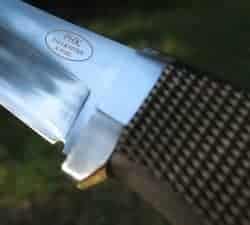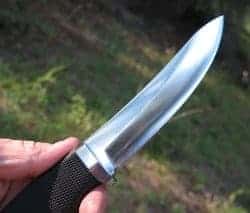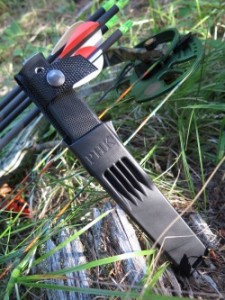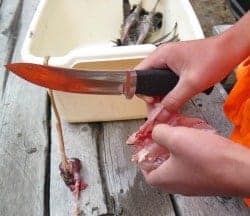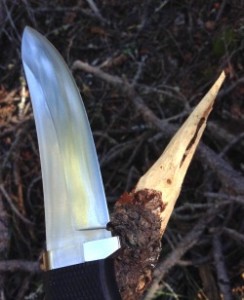There seems to be very few constants in knife making these days. I can think of two constants: human strength and cutting capacity. The ideal blade isn’t too dull, flexible, or blunt. If you will, the ideal blade is a ‘Goldilocks Blade’. Beyond that, there are few rules. With this being said, there are many traditions and these must be properly navigated in order to innovate.
SKIP AHEAD
The Hunted
Read Also: Survival Gear Review: Fällkniven A1 Pro
The Fällkniven Professional Hunting Knife, or PHK, is a gorgeous upswept-point blade of mildly larger proportions than dusty traditions would specify. Frankly, the moment I saw the design of this blade, I knew it would be good. There was just something so right about it. It carried forward the belly of a skinner with the rigidity of a wilderness blade while offering the user more control. The Fällkniven Professional Hunting Knife has an upsweep-drop point which seems like it could be an oxymoron, but in fact it’s the best of both worlds. Perhaps it is the best of all worlds.
The potentially contradictory blade shape of upswept-drop point is an irony of iron that really works. Traditionally upswept designs are elegant but small slicers are arguably more effective. When the blade exceeds the distance between palm and index finger, the whole hand must move beyond the grip. This motion compromises safety and is simply inefficient. It’s a dangerous move that requires practice especially when done quickly or blindly. On traditional larger drop point blades, the tip of the blade rides below the index fingernail meaning it’s easier to poke a hole into the skin or membrane during a slice. The pros can drag the tip precisely like a surgeon’s scalpel, but anything done in the field or elements is risky. And the more blood and sweat in the mix, the more likely the game won’t be the only one skinned. However, on the Fällkniven Professional Hunting Knife the upswept drop point allows fairly precise driving even from the back seat. The thick spine provides firm control and the added length in front of the fingertip is user friendly.
Iron Maiden
The iron coursing through the veins of the Fällkniven Professional Hunting Knife blade is a 3G laminated steel scoring a 62 on the Rockwell hardness scale (HRC). The tang is a broad protruding one that, like Fällkniven’s survival blades, pops out the back of the grip completing the solidity of this package. A single grommeted hole graces the far end of the kraton grip allowing a lanyard to be attached.
Related: Fallkniven A1 Survival Knife
Traditions Change
I think hunting knives began to evolve when hunting moved from an out-the-backdoor activity to a pseudo-military expedition into the untamed wilderness. There’s not a lot of hardware to carry when popping a Bambi off the back porch. You gut the beast right there donating the innards to the predators that keep the place clean and tidy. Afterwards, you drag the carcass back home and string it up on a tree to cool. When ready, you head to your kitchen for some meat and bone-specific cutlery.
All is fine and dandy until you are miles into the woods and your quarry might not go down willingly like the whitetail snacking on your hedges. Enter the big hunting knife. When money and carry-weight is tight, items seem to gain more uses. Military knives moved from BDU belt accessory to top-tier hunting wardrobe. The knife needed to run triple-duty as a camp knife for those lifetime adventures in the national parks, off-grid hunting expeditions, and self-defense.
Like all evolutionary change, as one critter specializes, another pops up to capitalize on the available niche. So as the hip-hugging hunting knife moved away from the detailed work and more towards bigger cruder jobs, little knives moved in like tiny mammals taking over the mini-landscape left behind as the dinosaurs grew bigger. Then, when the mighty asteroid dirtied up the place 65 million years ago, the little furry warmbloods made their move. And here we are, more or less.
Small is Big
In a strange twist on a perpetual theme, there was a movement that started out with good intentions but ended up causing a mess. That movement was fueled by the belief that the better a hunter you were, the smaller the knife you needed. This was the opposite of the Bowie and Tennessee Toothpick persona. Imagine Rambo whipping out his Spyderco Ladybug. Maybe let’s not. The issue rose to epic proportions when a hunting knife could be mistaken for a scalpel complete. Of course, another knife was needed for regular camp tasks, and an even larger blade was carried for the traditional forest duties. So add to the growing pile of knives the sharpening tools and extra blades necessary to keep the knives in the fight.
Further Reading: Three Excellent Survival Knives for Under $100
But the same evolutionary rules that lead to the population explosion of knives can also lead to extinction. Blades were staying home and hunters were squeezing more performance and specialized jobs out of knives obviously not designed for such work. As the proverbial pendulum began a healthy swing back towards center, so started another renaissance of sorts with hunting knives. The short ones got a little longer, thin ones got a little thicker, the pointy ones got a little more dropped, and knives of all kinds implemented the full belly of the skinner.
In general, the PHK guts like a gutter, skins like a skinner, chops like a chopper and slices like a slicer. It does none of these things quite as good as a blade specifically designed and dedicated to such tasks, but the PHK is well within the margin of error for modern task-specific cutlery. Adding to this list, the Fällkniven PHK also worked great as a minor clever as it crunched through upland game bird wings and legs with skill and finesse. The full belly rolls smoothly through all things aviary, and breaks the bones of any fish you can lift. But big game is another story. Processing hundreds of pounds of animal requires some seriously edged firepower so pushing eight inches of blade length around a carcass is a task well within the Fällkniven Professional Hunting Knife skill set.
Photos Courtesy Of:
Doc Montana


